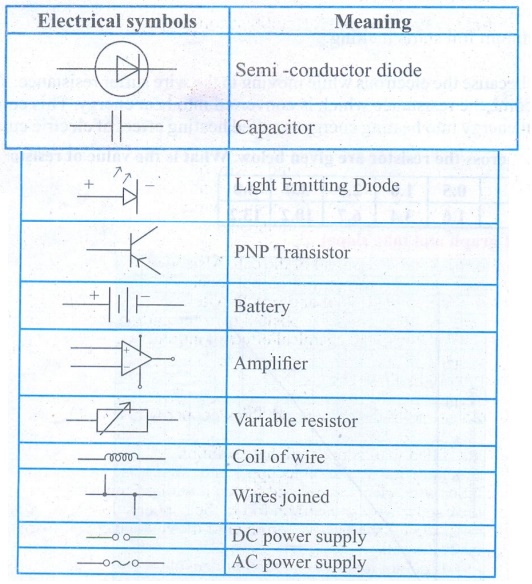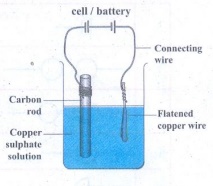Electric Charge and Electric Current | Physics | Science - Answer the following questions | 9th Science : Physics : Electric Charge And Electric Current
Chapter: 9th Science : Physics : Electric Charge And Electric Current
Answer the following questions
ELECTRIC CHARGE AND ELECTRIC CURRENT
TEXT BOOK EXERCISES
V. Conceptual questions:
1. A bird sitting on a high power
electric line is still safe. How?
Answer:
Birds
can sit on power lines and not get electric shocks because the electricity is
always looking for a way to get to the ground (i.e.) the current is not flowing
out of its body to any other material.
Current
flows in a loop (which means the circuit is closed). A bird sitting on a
transmission line does not complete the circuit. If the same bird keeps one leg
on one line and another leg or any part of its body on another line or the
neutral points, then it will get burnt.
2. Does a solar cell always
maintain the potential across its terminals constant? Discuss.
Answer:
Solar
cell delivers a constant current for any given illumination level, while the
voltage is determined by the load resistance. Potential in a solar cell depends
on the intensity of the solar radiation. Since the intensity of solar radiation
is not always constant, the potential across its terminal is also not constant.
3. Can electroplating be possible
with alternating current?
Answer:
The
heating effect and the chemical effect experiments have to be performed only
with a dc cell of around 9V. The 9V dc cell will not give any electrical shock.
At
any cost we should
not use the main domestic electric supply which is 220V ac voltage.
If it is used it will give a heavy electric shock leading to a severe damage to
our body.
VI. Answer the
following:
1. On what factors does the
electrostatic force between two charges depend?
Answer: The
numerical value (magnitude) of electric force between two charges depend on
the,
(i)
value of charges on them,
(ii)
distance between them and
(iii)
nature of medium between them.
2. What are electric lines of force?
Answer: The lines
representing the electric field are called electric lines of force.
3. Define electric field.
Answer: Electric field is the region around a charged
body within which its influence can be experienced (i.e) within which it can attract
or repel another charged body.
4. Define electric current and
give its unit.
Answer: The
electric current is defined as the rate of flow of electric charge through any
section
of a conductor.
Electric
current I = (Q / t)
Its
unit is Cs-1
Its
SI unit: ampere (A).
5. State Ohm’s law.
Answer: Ohm's law
states that, the current passing through a conductor is directly proportional
to the potential difference across its ends, provided the physical conditions
like temperature, density, etc. remain unchanged. V α I or V = IR.
6. Name any two appliances which
work under the principle of heating effect of current.
Answer: Electric
heating appliances like iron box, water heater, toaster, etc.
7, How are the home appliances
connected in general, in series or parallel. Give reasons.
Answer: In a
household electric circuit, different home appliances are connected in parallel
to one another due to the following reasons:
(i)
The appliances can be operated independently. If one appliance is switched off,
others remain unaffected.
(ii)
Each appliance gets the same constant voltage.
(iii)
In parallel connection of electrical appliances, the overall resistance of the
circuit it reduced due to which the current form the power supply is high.
8. List the safety features while
handling electricity.
Answer:
(i) Ground connection:
The
metal bodies of all the electrical appliances are to be connected to the ground
by means of a third wire apart from the two wires used for electrical
connection.
(ii) Trip switch:
It
is an electromechanical device which does not allow a current beyond a
particular value by automatically switching off the connection.
(iii) Fuse:
A
fuse is another safety mechanism which works on joule heating principle.
VII. Exercises:
1. Rubbing a comb on hair makes
the comb get − 0.4C.
(a) Find which material has lost
electron and which one gained it.
(b) Find how many electrons are
transferred in this process.
Answer:
a.
Comb gained electrons. Dry hair lost electron.
b.
No. of electrons transferred = − 0.4 C
1
coulomb = 6.25 × 1018 electron
−
0.4 C = 0.4 × 6.25 × 1018 electrons
= − 2.5 × 1018 electrons
2. Calculate the amount of charge
that would flow in 2 hours through an element of an electric bulb drawing a
current of 2.5A.
Answer:
Current
I = 2.5 A
time
t = 2hours = 2 × 3600 seconds
t = 7200s
Amount
of charge Q = I × t
= 2.5 × 7200
Q = 18,
000C
3. The values of current (I)
flowing through a resistor for various potential differences V across the
resistor are given below. What is the value of resistor?

[Solution: plot V-I
graph and take slope]
Answer:

Resistance
of the resistor R = ( V2 –V1 ) / (I 2 - I1)
=
(13.2 – 10.2) / (4 – 3)
= 3 / 1 = 3 Ω
R = 3 Ω
Intext Activities
ACTIVITY - 1
Take a condemned electronic
circuit board in a TV remote or old mobile phone. Look at the electrical
symbols used in the circuit. Find out the meaning of the symbols known to you.

ACTIVITY - 2
Cut an arrow shaped strip from
aluminium foil. Ensure that the head is a fine point. Keep the arrow shaped
foil on a wooden board. Connect a thin pin to two lengths of wire. Connect the
wires to the terminals of electric cell, may be of 9V. Press one pin onto the
pointed tip and other pin at a point about one or two mm away. Can you see that
the tip of aluminium foil starts melting?

Aim:
To
understand the heating effect of electric current.
Materials Required:
Aluminium
strip, wooden board, bell pins, cell of 9 V.
Procedure:
Cut
an arrow shaped strip from aluminium foil. Keep the arrow shaped foil on a
wooden board. Connect a pin to two lengths of wire. Connect the wires to the
terminals of electric cell of 9 V. Press one pin onto the pointed tip and
another pin at a point about one or two mm away.
Observation:
The
tip of aluminium foil starts melting.
Conclusion:
It
starts melting because the electrons while moving in the wire suffer
resistance. Work is done to overcome the resistance which is converted into
heat energy. This conversion of electrical energy into heating energy is called
heating effect of electric current.
ACTIVITY - 3
Take a beaker half filled with
copper sulphate solution. Take a carbon rod from a used dry cell. Wind a wire
on its upper end. Take a thick copper wire, clean it well and flatten it with a
hammer. Immerse both the copper wire and carbon rod in the copper sulphate
solution. Connect the carbon rod to the negative terminal of an electric cell
and copper wire to the positive terminal of the cell. Also ensure that the
copper and the carbon rod do not touch each other, but are close enough. Wait
and watch. After some time you would find fine copper deposited over the carbon
rod. This is called as electroplating. This is due to the chemical effect of
current.

Aim:
Electroplating
carbon rod with copper.
Materials Required:
Beaker,
copper sulphate solution, carbon rod, thick copper wire and hammer.
Procedure:
•
Take a beaker half filled with copper sulphate solution.
•
Take a carbon rod and wind a wire on its upper end.
•
Take a thick copper wire, clean it well and flatten it with a hammer.
•
Immerse both the copper wire and carbon rod in the copper sulphate solution.
•
Connect the carbon rod to the negative terminal of the cell and copper wire to
the positive terminal of the cell.
•
Ensure both the rods do not touch each other, but are close enough.
•
Observe for some time.
Observation:
After
some time, we would find fine copper deposited over the carbon rod.
Conclusion:
When
the current passes through the copper sulphate solution, the copper ions
migrate from the copper sulphate solution towards the cathode (-ve terminal).
These copper ions get deposited on the carbon rod and form a coating of a fine
layer on it. This process of coating a metal over another metal by electrolysis
is called electro-plating. This is due to chemical effect of electric current.
Related Topics